Content
- Etiology and pathogenesis of ischemic heart disease
- Risk factors for coronary heart disease
- Varieties of the disease
- Acute ischemic heart disease
- Chronic ischemic heart disease
- Symptoms
- Sex differences in the course of ischemic heart disease
- Clinical features of the varieties of ischemic heart disease
- Signs of special forms of ischemic heart disease
- Diagnostics
- Laboratory research methods
- Electrocardiography
- Angiography
- Holter ECG monitoring
- Load samples
- Echocardiography
- Rules for the treatment of coronary heart disease
- The effect of drugs, names of drugs, dosage regimens
- Nitrates
- Beta-blockers
- ACE inhibitors
- Statins
- Antiplatelet and anticoagulants
- Calcium antagonists
- Diuretic
- Antiarrhythmics
- Cytoprotectors
- Folk remedies
- Hawthorn
- Horseradish
- Garlic
- Disease prognosis
- Ischemic Heart Disease Videos
Ischemic heart disease (ischemic heart disease) Is a pathological process that occurs in the area of the heart muscle (myocardium) and has an organic and functional nature of origin. The disease has pronounced symptoms and requires compulsory treatment.
Etiology and pathogenesis of ischemic heart disease
The pathological process develops against the background of the relationship of the coronary circulation and a sufficient supply of blood to the heart muscle. Insufficient blood flow to the myocardium in most cases is accompanied by a decrease in coronary blood flow.
The process leads to a disruption in the supply of blood and oxygen to the tissues of the heart, which causes the occurrence of ischemic diseases.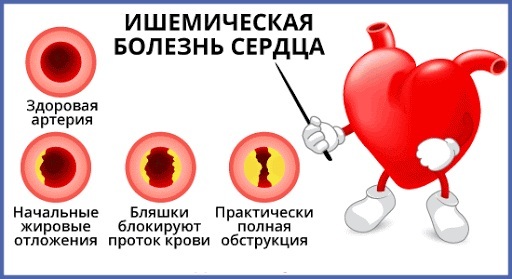
With a long-term diagnosis, the pathology causes dystrophy, necrotic lesions, or contributes to the development of sclerosis.
Risk factors for coronary heart disease
There are several main provoking factors that cause the development of diseases.
In most cases, the pathology occurs against the background of atherosclerotic plaque lesions of the coronary arteries. With a lack of oxygen, the myocardium begins to work harder, as a result of which exertional angina develops.
Other risk factors:
- High blood pressure. A high level of blood pressure increases the risk of developing ischemic disorders by 2 to 6 times. In this case, the pathology is found in hypertensive patients times more often than in people with low blood pressure.
- Hyperlipidemia. This disease is one of the main reasons for the development of atherosclerosis and increases the risk of coronary artery disease from 2 to 5 times.
- Smoking. The risks of ischemia in this case increase from 2 to 6 times. The mortality rate among smoking men is 2 times higher than among non-smokers.
-
Diabetes. In this case, the risks of coronary artery disease increase by 2-4 times.

Also, the reasons for the development of ischemic diseases can be such factors as the elderly age of a person, heredity, gender (risk group - men), sedentary lifestyle and, as a result, overweight.
Varieties of the disease
IHD of the heart (symptoms and treatment for each form of the disease are different) by the nature of the course is divided into 2 main forms - acute and chronic. Each form has its own developmental characteristics and signs.
Acute ischemic heart disease
With the development of an acute form of the disease, a blockage of blood flow in the arteries occurs. The violation occurs against the background of a rapid blockage of blood vessels (mainly large), as a result of which an acute attack develops, since other arteries and vessels do not have time to supply the heart and tissues with blood.
Most often, with such attacks, myocardial infarction and stroke occur.
Chronic ischemic heart disease
The chronic form develops gradually over a long period of time. Contributes to its occurrence atherosclerotic plaques and vascular compression.
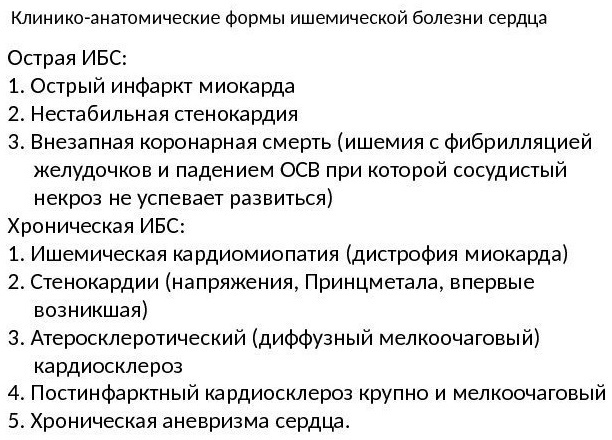
At this stage, other auxiliary vessels are involved in the process, however, the situation is complicated by the fact that the load on these vessels also increases, which leads to various manifestations. The disease can ultimately lead to the development of heart failure.
Symptoms
Determine the presence of pathology can be determined by external and internal manifestations. Each form of the disease has its own symptoms and nature of the course, therefore, only a doctor can make an accurate diagnosis.
Sex differences in the course of ischemic heart disease
Mortality in coronary artery disease among men is 2 times higher than among women. This is due to the presence of estrogens in the female body, which have a beneficial effect on the cardiovascular system.
Experts note that female obesity is less predisposing than male obesity. However, despite this fact, women are much more likely to suffer from high blood pressure, diabetes and excess weight.
Smoking is a provoking factor in the development of ischemic disorders in women.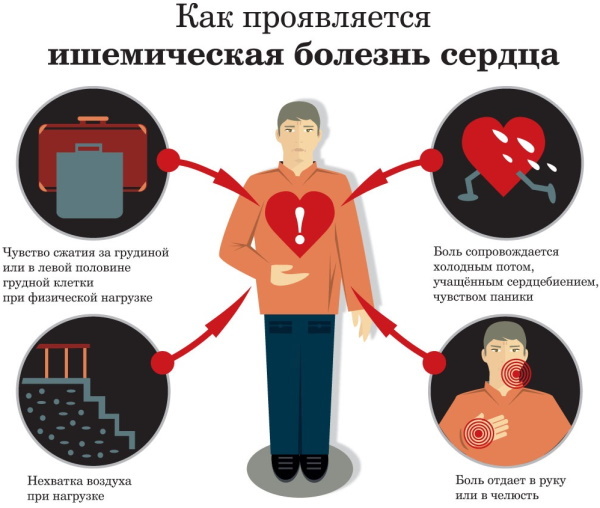
According to studies, 47% of women develop angina pectoris against the background of pathology. At the same time, in men, in 46% of cases, a heart attack occurs.
A heart attack in women is fraught with death and the development of complications to a greater extent than in men. The defeat of the coronary vessels among women is much more common and more complex. However, the risks of stenosis in women are lower.
Clinical features of the varieties of ischemic heart disease
IHD of the heart (symptoms and treatment depend on the established type of disorder) is divided into 9 main forms, therefore, each type has its own distinctive signs and manifestations.
Forms and symptoms:
- Sudden coronary death. The condition is characterized by loss of consciousness and cardiac arrest. In the absence of effective and timely resuscitating actions, a lethal outcome occurs.
- Exertional angina. The main symptom of the disorder is soreness in the chest area. With a decrease in physical activity or taking nitrates, the attacks stop within a few minutes.
-
Heart attack. Signs: chest pain, discomfort, burning sensation. At the same time, nitrates are ineffective. Weakness, shortness of breath, loss of consciousness, sweating, speech disorders, dyspeptic disorders may also develop.

- Postinfarction cardiosclerosis. The condition has a similar clinical picture with heart failure: palpitations, shortness of breath (during physical activity), weakness, hyperhidrosis, edema in the lower extremities.
- Arrhythmias and blockages. The main symptoms: increased heart rate, a feeling of heart sinking. Occasionally, weakness or sweating may occur.
- Chronic heart failure. The main symptom of pathology is edema in the lower extremities. When the condition worsens, the swelling may rise higher. Weakness, fatigue and shortness of breath also occur.
All violations require immediate medical attention, since they pose a high danger to the health and life of the patient.
Signs of special forms of ischemic heart disease
Special forms of the disease include cardiac X-syndrome, refractory and vasospastic forms of angina pectoris. Symptoms of abnormalities are similar to angina pectoris, however, standard treatment is ineffective. Plus, there are additional symptoms in the form of vascular spasms.
Also, painless myocardial ischemia belongs to special forms. The violation is difficult to detect, since there is no pain during its development. Additional diagnostics and immediate treatment are required.
Diagnostics
It is possible to diagnose ischemic diseases only with a comprehensive examination, which includes many instrumental and laboratory methods.
Laboratory research methods
For laboratory research, tests are prescribed. First of all, the patient needs to take a blood test (general and biochemical examination). It is also required to undergo a test for blood sugar and enzyme content.
Diagnostics allows you to assess the characteristics of the blood - the erythrocyte sedimentation rate, hemoglobin level, the amount of electrolytes (potassium and sodium) contained.
In addition, a general urine test should be passed.
Electrocardiography
An ECG is performed primarily after a visual examination and anamnesis. The study allows you to get a graphic image of the work of the heart, to determine the contractile function of the atria and ventricles.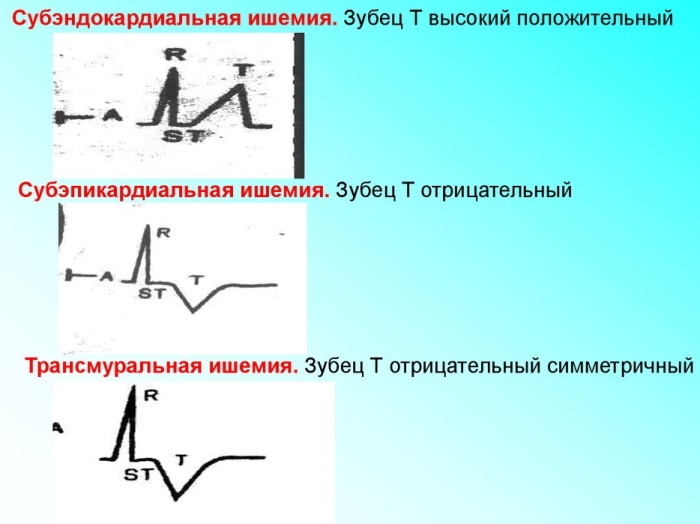
With a heart attack, a Q wave will appear on the cardiogram. There will also be an increase in the ST segment. With heart failure, there is an elongation of the main segments and a change in the ventricular complexes. An accurate diagnosis can only be made by a specialist, taking into account all internal and external manifestations.
Angiography
This procedure allows you to assess the degree of narrowing of the vascular lumen. In this case, a contrast agent is used to enhance the effect. In some cases, during the study, an operation is performed to expand the vessels, which allows you to install a special hollow mesh tube (shunt).
Holter ECG monitoring
This type of diagnosis allows you to track the work and rhythms of the heart for a long time (up to 1 week).

During the examination, a special sensor (apparatus) is attached to the patient, which monitors and registers the work of the organ. In this case, the patient must keep a special diary, where the indicators are entered. At the end of the diagnosis, the data and the device are transmitted by a specialist who is engaged in decoding and diagnosing.
Load samples
IHD of the heart in some cases can occur only after any physical effort, so the symptoms may be absent or mild, which complicates the diagnosis and determination of methods treatment.
Diagnostics includes a whole range of specially developed methods - 6-minute walk, exercise on a stationary bike. The study is carried out in the presence of a specialist to clarify the diagnosis or determine the treatment regimen. With a sharp deterioration in the patient's well-being, testing is stopped.
Echocardiography
The study is carried out using a special ultrasound apparatus.
It allows you to explore the following aspects:
- assessment of the size of the chambers of the heart;
- determination of the thickness of the walls of the organ;
- study of contractile function;
- the presence of neoplasms - blood clots, tumors, cysts.

During the procedure, the doctor examines how the valves work and also monitors the rhythm and heart rate.
This type of examination is recommended for chronic ischemic diseases.
Rules for the treatment of coronary heart disease
During therapy, it is necessary to adhere to certain principles, which will avoid complications and increase the chances of recovery.
Treatment rules:
- Blood pressure control. It is necessary to measure the pressure regularly and avoid prolonged excess of it. Carry out control independently using a tonometer.
- Measuring blood sugar. It is required to systematically undergo a blood test for sugar levels.
- Food. The diet should be rich in vitamins and contain a minimum amount of cholesterol.
- Compliance with sleep patterns. This will avoid overexertion or overwork. On average, you need to sleep from 7 to 10 hours.
- Walking. The patient should be sure to stay in the fresh air every day for about 1 hour, which will saturate the blood with oxygen and improve the quality of sleep.
It is also recommended to completely abandon bad habits such as smoking and alcoholic beverages, since they are provoking factors in the development of ischemic diseases.
The effect of drugs, names of drugs, dosage regimens
IHD of the heart (symptoms and treatment of the disorder should be systematically monitored by a doctor) requires an integrated approach, including taking various medications.
The choice of this or that remedy depends on the form of the violation and the degree of its severity.
Nitrates
This group of drugs is prescribed in the presence of various ischemic diseases. It has antianginal and anti-ischemic effects.
The funds help restore blood flow in the coronary arteries and smaller vessels. They help fight angina attacks.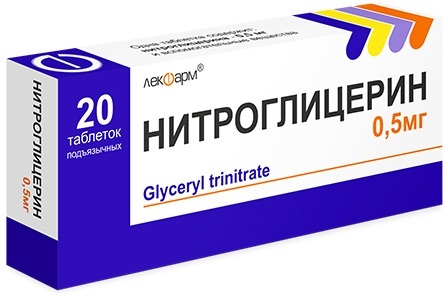
Representatives: Nitroglycerin, Molsidomin, Amylnitrite.
Take funds for attacks 1 time per day. It is recommended to use isosorbide dinitrate according to the scheme of intermittent intake: 2 times a day - in the morning and in the evening instead of the prescribed 4 times.
Beta-blockers
The action of this group of drugs is aimed at the receptors of cells, which leads to a decrease in the strength and heart rate. Thanks to this, the work and oxygen demand of the heart muscle decreases.
| Drug name | Reception scheme |
| Metoprolol | 100 mg per day, divided into 1-2 equal doses. If necessary, the dosage can be increased to 200 mg. |
| Bisoprolol | The daily dosage ranges from 2.5 to 15 mg. It is taken once a day. |
| Atenolol | In the first days of therapy, appoint 50 mg 1 time per day. The duration of treatment is 7-14 days. Then the daily rate is increased to 100 mg. |
| Propranolol | The initial dosage is 20 mg 2-3 times a day. The maximum single dose is 40 to 80 mg. The duration of therapy can be up to six months. |
ACE inhibitors
Taking this group of medicines helps to improve the condition of the heart chambers and reduces hypertrophic changes in the myocardium. ACE inhibitors significantly reduce the risk of death after a heart attack.
Recommended remedies in the presence of heart failure. However, they can be used as part of complex treatment and for other forms of coronary artery disease.
Preparations:
- Captopril - 25-50 mg 2-3 times a day. The duration of therapy varies from 2 weeks to 1 month.

- Enalapril - the initial dosage is 5 mg per day. If necessary, the dose can be increased to 10-20 mg 1-2 times a day.
- Ramipirl - 1.25-2.5 mg 1-2 times a day.
Before using drugs, you should read the instructions for their use, especially with contraindications.
Statins
Medicines of this group lower the level of cholesterol in the blood, normalize the concentration of lipoproteins. At the same time, they help to reduce the level of lipid fractions, which are responsible for the production of cholesterol.
Drugs: Rosuvastatin, Atorvastatin, Simvastatin. The reception scheme is standard. Start with 20 mg per day. Then the dosage is gradually increased. Duration of use - until the normalization of indicators.
Antiplatelet and anticoagulants
IHD of the heart (symptoms and treatment should be determined only by a specialist, taking into account the patient's physiology) requires an integrated medical approach, including the use of antiplatelet agents and anticoagulants.
The action of these medicines is aimed at suppressing the aggregation of platelets and red blood cells, which leads to an improvement in blood flow.
The products help thin the blood and prevent blood clots. They are also used to prevent complications from ischemic disorders.
Medicines:
- Clopidogrel - the standard dosage is 75 mg once a day. The duration of the course is up to 1 year.
-
Cardiomagnet - appoint 75-150 mg once a day. Duration of admission - according to the testimony of a doctor.
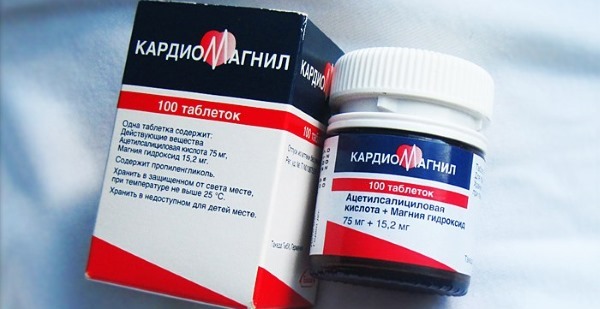
Aspirin (acetylsalicylic acid) can also be used. Standard dosages - 75-150 mg 1 time per day.
Calcium antagonists
These agents act on calcium channels, thereby dilating blood vessels and improving blood flow. This leads to a decrease in heart rate and normalization of the heart.
The most popular drugs are Verapamil and Diltiazem.
The first agent is used in the form of intravenous injection. Introducing slowly 2-4 ml of 0.25%. If necessary, the solution is re-injected after half an hour at the same dosage.
Diltiazem dosage regimen: tablets - 60 mg 3 times a day. The maximum dosage is 180 mg 2 times a day. A single dose for intravenous administration is 300 μg / kg.
Diuretic
This group of funds is prescribed if there is excess fluid in the body and edema. The drugs reduce the load on the myocardium and restore normal blood circulation.
Medicines:
- Indapamide - 1 tablet once a day (in the morning).
- Furosemide - the initial dosage is 20-80 mg per day, divided into 2-3 equal doses. The maximum daily allowance should not be more than 1500 mg.

Drugs should only be taken under the supervision of a healthcare professional.
Antiarrhythmics
This drug group is used for various types of arrhythmias, as a maintenance treatment after a heart attack or heart failure.
The antiarrhythmic action of the funds is due to the improvement of metabolic processes in cardiomyocytes.
Medicines:
- Asparkam - the agent is administered intravenously in a stream of 500 mg 1-2 times a day.
- Panangin - the solution is injected intravenously at a rate of 20 drops per minute. If necessary, the dosage is repeated after 4-6 hours.
Injection solutions are used only in a hospital setting.
Cytoprotectors
This group of drugs has an antianginal effect, improves metabolic processes and prevents the development of oxygen starvation by the heart muscle.
The most popular remedy is Mildronate. The drug is taken at 500 mg 1-2 times a day, depending on the severity of the pathology. The duration of therapy can vary from 7 days to 1.5 months.
Folk remedies
IHD of the heart (symptoms and treatment of pathology can be determined only after all the studies have been carried out) can be controlled using home remedies.
Traditional methods of treatment are used as auxiliary measures and can be used only after agreement with the attending specialist.
Hawthorn
It is recommended to take tea made from hawthorn fruit. To do this, take 1 tbsp. dry berries and pour 0.5 liters of boiling water. Insist for 15 minutes. The product is divided into 2 equal portions and consumed at intervals of 6 hours.
This infusion helps to strengthen the myocardium, normalize blood pressure and restore heart rate.
Horseradish
Horseradish helps restore blood supply and oxygenate heart tissue.
Preparation: mix 100 g of the plant with the same amount of honey. Take 1.5 tsp in the morning. The product can be taken with water or tea. It is taken within 1 month, after which it is necessary to take a break for at least 3 weeks.
Inhalation can also be carried out with the plant. To do this, finely grate fresh horseradish to make 1 tbsp. Pour boiling water over and breathe in pairs for 15 minutes.
Garlic
Garlic can be used as a condiment for main dishes. It is also recommended to eat 1 clove a day. The tool helps to restore blood circulation, relieve pain and prevent the development of inflammatory processes.
Disease prognosis
The world statistics of mortality from pathology over the past few years has remained at the level 70%, therefore the problem is urgent and poses a serious threat to health and life the patient.
Sudden coronary death occurs in 10% of cases. At the same time, in 50% of the disease there is a myocardial infarction. In the absence of emergency assistance, this is fatal.
 In the absence of timely therapy, the life expectancy of patients with coronary artery disease is about 5 years. When carrying out interventions and other therapeutic methods, the quality of life of patients is significantly improved, and the life expectancy increases several times.
In the absence of timely therapy, the life expectancy of patients with coronary artery disease is about 5 years. When carrying out interventions and other therapeutic methods, the quality of life of patients is significantly improved, and the life expectancy increases several times.
With the development of the first symptoms of coronary artery disease, it is recommended to immediately consult a doctor who will conduct all the necessary studies and prescribe appropriate treatment.
Ischemic Heart Disease Videos
Ischemic heart disease, angina pectoris:
